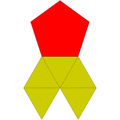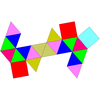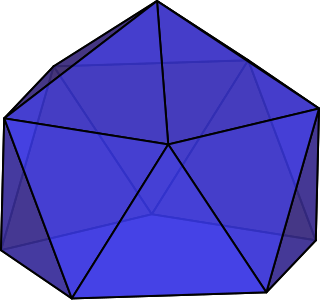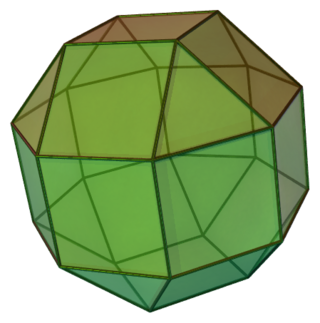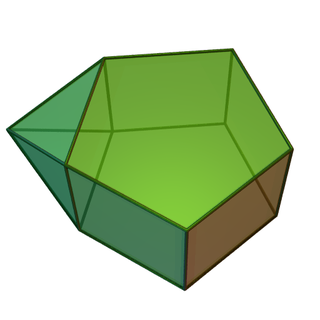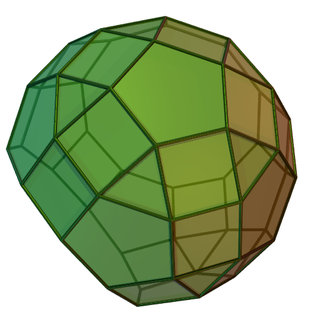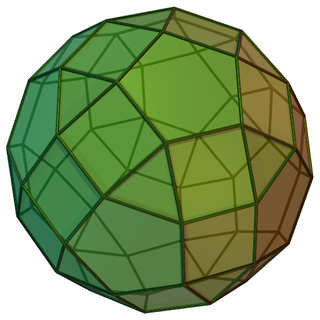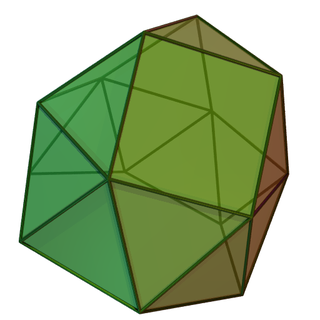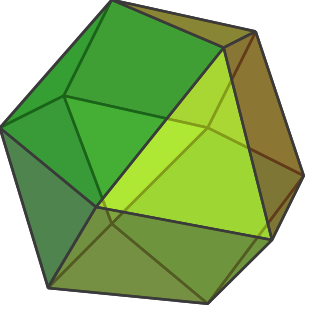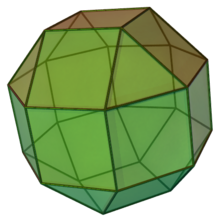
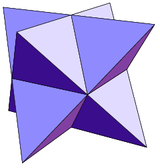
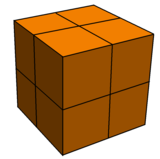
In geometry, a Johnson solid is a strictly convex polyhedron each face of which is a regular polygon. There is no requirement that each face must be the same polygon, or that the same polygons join around each vertex. An example of a Johnson solid is the square-based pyramid with equilateral sides (J1); it has 1 square face and 4 triangular faces. Some authors require that the solid not be uniform (i.e., not Platonic solid, Archimedean solid, uniform prism, or uniform antiprism) before they refer to it as a "Johnson solid".
Contents
- Names
- Enumeration
- Pyramids, cupolae, and rotundas
- Modified pyramids
- Modified cupolae and rotundas
- Augmented prisms
- Modified Platonic solids
- Modified Archimedean solids
- Elementary solids
- Classification by types of faces
- Triangle-faced Johnson solids
- Triangle and square-faced Johnson solids
- Triangle and pentagon-faced Johnson solids
- Triangle, square, and pentagon-faced Johnson solids
- Triangle, square, and hexagon-faced Johnson solids
- Triangle, square, and octagon-faced Johnson solids
- Triangle, pentagon, and decagon-faced Johnson solids
- Triangle, square, pentagon, and hexagon-faced Johnson solids
- Triangle, square, pentagon, and decagon-faced Johnson solids
- Circumscribable Johnson solids
- See also
- References
- External links
As in any strictly convex solid, at least three faces meet at every vertex, and the total of their angles is less than 360 degrees. Since a regular polygon has angles at least 60 degrees, it follows that at most five faces meet at any vertex. The pentagonal pyramid (J2) is an example that has a degree-5 vertex.
Although there is no obvious restriction that any given regular polygon cannot be a face of a Johnson solid, it turns out that the faces of Johnson solids which are not uniform (i.e., not a Platonic solid, Archimedean solid, uniform prism, or uniform antiprism) always have 3, 4, 5, 6, 8, or 10 sides.
In 1966, Norman Johnson published a list which included all 92 Johnson solids (excluding the 5 Platonic solids, the 13 Archimedean solids, the infinitely many uniform prisms, and the infinitely many uniform antiprisms), and gave them their names and numbers. He did not prove that there were only 92, but he did conjecture that there were no others. Victor Zalgaller in 1969 proved that Johnson's list was complete.
Of the Johnson solids, the elongated square gyrobicupola (J37), also called the pseudorhombicuboctahedron, [1] is unique in being locally vertex-uniform: there are 4 faces at each vertex, and their arrangement is always the same: 3 squares and 1 triangle. However, it is not vertex-transitive, as it has different isometry at different vertices, making it a Johnson solid rather than an Archimedean solid.
87 of the 92 Johnson solids have the Rupert property: a copy of the solid, of the same or larger shape, can be passed through a hole in the solid. [2]





